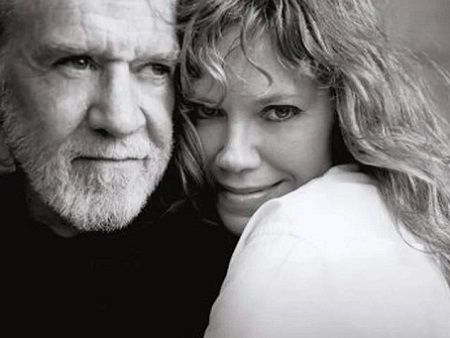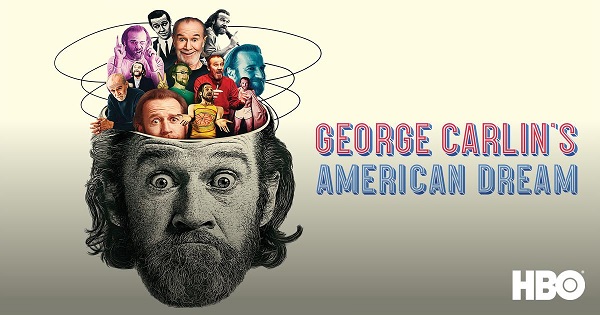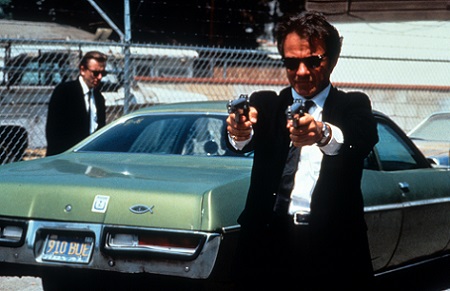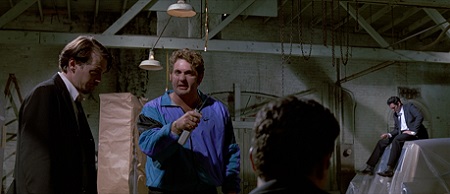The HBO documentary of comedian George Carlin aired in two episodes this past weekend. George Carlin’s American Dream (2022) offered a fuller look into the man, his career and his life than I ever had seen and read before, attracting commentary from contemporary and subsequent comedians, family, and industry colleagues both directly and through archive. The use of Carlin‘s own writings and archive footage were also used. Judd Apatow and Michael Bonfiglio directed and produced the documentary.

“In the 1960s, George Carlin enters the scene as a straightlaced stand-up, but soon gains notoriety for his fearless countercultural comedy,” as quoted from HBO here. Jack Burns was an early partner for this straightlaced period from their radio days in Fort Worth, Texas, as we saw in Part 1 of George Carlin’s American Dream. It is during this period that Carlin meets and marries Brenda Carlin (Hosbrook), whom he meets in Dayton, Ohio. The couple had one child, a daughter named Kelly Carlin-McCall.

The partnership with Burns lasted a couple of years, through radio and early television appearances from audition tapes in Hollywood, California. The two worked at a television station while working their craft in coffee houses at night, later moving onto television variety shows. Guest appearances on The Tonight Show Starring Jack Paar and The Tonight Show Starring Johnny Carson for Carlin, who eventually broke from Burns, were a part of this period. This phase of Carlin‘s career lasted through the late 1960s, was relatively profitable compared to the period that followed, and ended in a straightlaced fashion around the end of the decade, despite continued guest hosting of Carson‘s The Tonight Show.

The first major transition of George Carlin‘s comedy into a more countercultural comedy began approximately in 1970. The transition began with the first episode of the documentary, with the remainder of the comedian’s life and comedy addressed with Part 2. “Fellow comics reflect on George Carlin‘s later years and how his prescient political commentary continues to resonate today,” as quoted from HBO here. We get further into the background of Carlin the man, moving beyond the complex relations with his deceased and abusive father, his controlling mother, and his abused brother. We see the complexity of the relations with Carlin‘s first wife and daughter, and subsequent marriage to Sally Wade.

George Carlin‘s career took a major turn when he began using cocaine and his first wife began drinking when losing a connection to helping her husband’s career, like she had at the beginning of their marriage. The use of language became much more pointed and anti-authority. Record albums recorded in the 1970s proved helpful financially, yet complexities did not. The Seven Dirty Words routine, which changed legal history more than a decade after Lenny Bruce was arrested in Chicago, Illinois for swearing in his routine, would offer indecency guidelines. Carlin would become the first guest host of NBC‘s Saturday Night Live in this period, something he would repeat in 1984 after his 1981 A Place for My Stuff album and his 1982 Carlin at Carnegie television special. The 1990s and 2000s would see shifts into increasingly political subjects, including about abortion, race, people as individuals rather than in groups, and in frustration with how decisions were made and the lack of perceived influence over large scale life individual people really have.

George Carlin’s American Dream provides a deeper dive into the career and life underpinning the man than I have provided here. The insight into the cultural force that the man’s thoughts and feelings were, culturally, as well as offering a sense for the flawed man that existed underneath offer an insight that were shown with a comprehensive quality that in fact was quality. The bridging of the messaging from Carlin‘s past into today was also an achievement, both for the man and the documentary. I give the documentary George Carlin’s American Dream as directed by Judd Apatow and Michael Bonfiglio 4.25-stars on a scale of 1-to-5.
Matt – Wednesday, May 25, 2022







